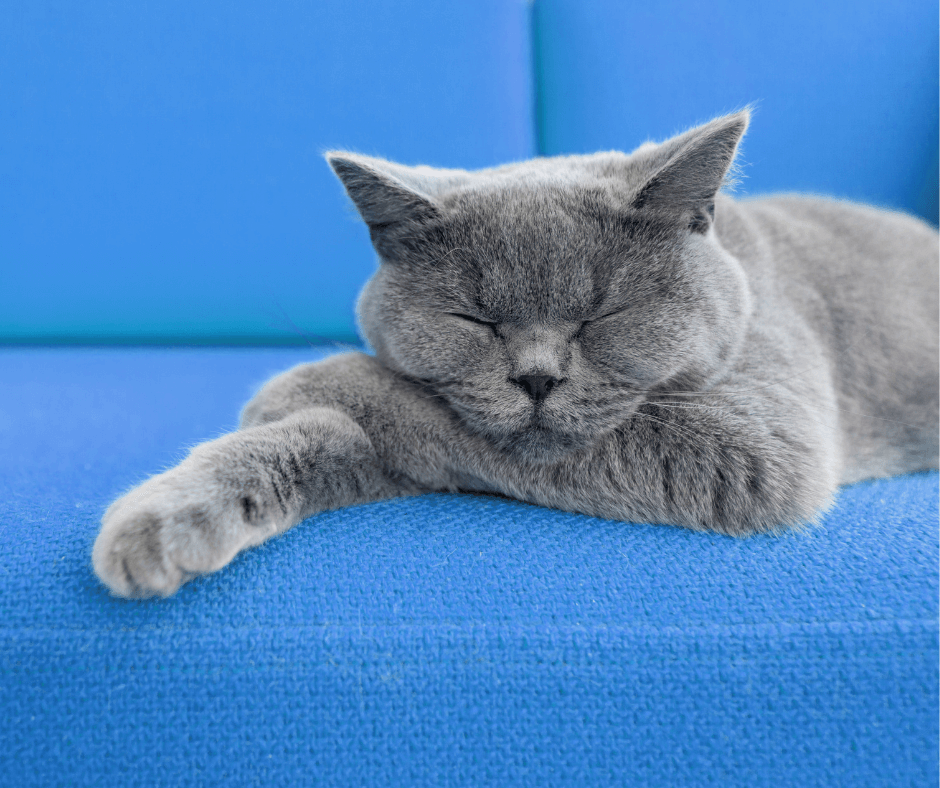Catnaps — The Sleeping Behaviour of Cats

When it comes to sleep, cats are the envy of the world. But their mysterious sleep patterns can vary; different living conditions can affect their sleeping behaviour. Their sleep positions may give us a clue as to how they feel. Let’s take a look at the sleeping behaviour and sleep positions of our cats.
How Much Sleep Do Cats Need?
How much is enough sleep for a cat, and how much is too much? The amount of sleep our kitty cat needs each day varies, depending on their stage of life.
Kittens can sleep up to 20 hours a day, and much of that will be deep sleep, thanks to growth hormones. The number of sleep hours will gradually decrease as they approach adulthood.
Adult cats sleep for anywhere between 14 and 18 hours, depending on their level of activity. But most of this sleep is light, allowing them to instantly spring into action.
By the senior years, cats will increase sleep hours, owing to a reduction in activity as they age.
If your cat is sleeping beyond these general parameters, that might be okay; every cat is unique. But take care if there is anything out of the ordinary. Look out for a sudden increase in sleep, loss of appetite, vomiting, diarrhoea or weakness. Take them to your vet to rule out serious underlying problems.
A Cat’s Natural Sleep Pattern
Cats that spend most of their time outdoors – particularly those that are outside at night – tend toward their wild cousins’ feral nature and develop a more “nocturnal” sleep pattern. Which leads to another question, are we fighting a losing battle against their natural needs?
Interestingly, cats are not truly nocturnal. By nature, they are more active in the twilight hours — sunrise and dusk. At these hours they love to hunt, or even play-hunt with toys and other lifeless objects, such as a ball of scrunched up paper. But little creatures of interest, like mice, come out to feed and forage while we sleep, increasing your cat’s interest in the outdoors at night.
Just as intriguing is the effect on cats that we, their guardians, make to their sleep behaviour. Kittens and juveniles aside, adult cats that spend all or most of their time indoors and in our company tend to adopt a sleep pattern much like ours. Some may need encouragement; playing with and stimulating them during the day can pull them into our time zone. Much like controlling a child’s nap time; parents limit their sleep during the day to ensure they, and you, get a good night’s sleep. The same principle applies to cats.
Unique Nature of a Cat’s Sleep
Cats seem to sleep a lot, but much of it is light sleep. You may notice that their eyes aren’t always completely closed, or their ears are moving and twitching. They are in a semi-asleep, dozing state that allows them to keep on the lookout, whilst resting and conserving energy – and they can do this for hours. In this state they can be ready to move, pounce or run off instantly, hyper aware of what is happening in their surroundings.
Another factor that affects the sleep behaviour of cats is the weather. Much like dogs, cats love to lie in the sun, soaking up its warmth. They look for areas of warmth to snuggle upon — a perfect excuse for a cuddle. A cat’s basal body temperature is a good 2ºC above ours. So in the colder months, a cat will sleep more to conserve heat.
Cat Sleeping Positions
Cats’ sleep positions are fascinating, adorable and can be an indication of how they feel.
Curled up in a ball — this position conserves body heat, and in the wild their untamed, larger cousins also use this position to appear small, and hence an unappealing target.
Stretched out on side — this position may indicate that they are too hot. It also indicates they feel safe, leaving their belly exposed.
Belly up — this endearing position shows that this kitty cat feels completely safe and secure in their environment.
Loaf — with their legs folded or tucked under, this is another heat conserving position. It may not look particularly restful, but it is ideal for that dozing state we looked at earlier.
Paws over the eyes — or a face plant, when our cats do this, not only does it melt our hearts, but it is simply a means to blocking out bright light.
Stretched out in a line — such as along a ledge, a sofa arm or the top of a garden wall. This is another one of their chilled out positions that indicates they are feeling safe, as it is not a position that helps them make a speedy getaway.
Contorted — cats have an incredibly flexible spine, so if they feel like it, they can twist their bodies just because they can. And of course, that exposed belly shows that they know they are safe to do so.
Cats Are All Unique
Any of these sleep positions might just be your cat’s comfort preference, according to cat behaviourist, Jackson Galaxy. He says that some positions may not mean anything at all, especially if your cat is healthy and safe. But he does state that if your cat suddenly changes their sleeping position, especially if they are getting into hidden places, like the back of a drawer or inside a dark cupboard, that might indicate something isn’t right. Keep an eye on them — their energy, eating and toilet habits — and take them to your veterinarian if you notice any changes for the worse. Read more about Cat Emergencies to Attend to Immediately.
The world of cat sleep is fascinating, enviable and charming. As well as giving us an insight into how they feel, keeping in mind their needs and inclinations can ensure that they are happy and healthy. And that we can enjoy a good night’s sleep.
